Pull Back Alert
The Pull Back Alert indicator
is based on the Volume Spread Analysis technique of chart
analysis.
Volume Spread
Analysis (VSA) is a form of technical analysis which attempts to look
into price action in
relation to volume. VSA is the study of the market forces of supply
and demand and the manipulation of those forces through the
psychology of crowd behavior, through examining the relationship
between the quantity of volume on a price bar, the spread of the
price or range of the bar, and the closing price on the height of
that bar. Studying these variables establishes the equilibrium of
demand and supply as well as the likely near term direction of the
market.
Rediscover the Lost Art of
Chart Reading
Using Volume Spread
Analysis
Credit To: Todd
Krueger
Most traders are aware of the two widely known
approaches used to analyze a market, fundamental analysis and
technical analysis. Many different methods can be used in each
approach, but generally speaking fundamental analysis is concerned
with the question of why something in the market will happen, and
technical analysis attempts to answer the question of when
something will happen.
There is, however, a third approach to
analyzing a market. It combines the best of both fundamental and
technical analysis into a singular approach that answers both
questions of “why†and “when†simultaneously; this
methodology is called volume spread analysis. The focus of this
article is to introduce this methodology to the trading community,
to outline its history, to define the markets and timeframes it
works in, and to describe why it works so well.
What is Volume Spread Analysis?
Volume spread analysis (VSA) seeks to
establish the cause of price movements. The “cause†is quite
simply the imbalance between supply and demand in the market, which
is created by the activity of professional operators (smart money).
Who are these professional operators? In any business where there
is money involved and profits to make, there are professionals.
There are professional car dealers, diamond merchants and art
dealers as well as many others in unrelated industries. All of
these professionals have one thing in mind; they need to make a
profit from a price difference to stay in business. The financial
markets are no different. Doctors are collectively known as
professionals, but they specialize in certain areas of medicine;
the financial markets have professionals that specialize in certain
instruments as well: stocks, futures, forex, etc.
The activity of these professional operators,
and more important, their true intentions, are clearly shown on a
price chart if the trader knows how to read them. VSA looks at the
interrelationship between three variables on the chart in order to
determine the balance of supply and demand as well as the probable
near term direction of the market. These variables are the amount
of volume on a price bar, the price spread or range of that bar (do
not confuse this with the bid/ask spread), and the closing price on
the spread of that bar.
With these three pieces of information a
properly trained trader will clearly see if the market is in one of
four market phases: accumulation (think of it as professional
buying at wholesale prices), mark-up, distribution (professional
selling at retail prices) or mark-down. The significance and
importance of volume appears little understood by most
non-professional traders. Perhaps this is because there is very
little information and limited teaching available on this vital
part of chart analysis. To interpret a price chart without volume
is similar to buying an automobile without a gasoline tank. For the
correct analysis of volume, one needs to realize that the recorded
volume information contains only half of the meaning required to
arrive at a correct analysis. The other half of the meaning is
found in the price spread (range).
Volume always indicates the amount of activity
going on, and the corresponding price spread shows the price
movement on that volume. Some technical indicators attempt to
combine volume and price movements together, but this approach has
its limitations; at times the market will go up on high volume, but
it can do exactly the same thing on low volume. Prices can suddenly
go sideways, or even fall off, on exactly the same volume! So there
are obviously other factors at work on a price chart. One is the
law of supply and demand. This is what VSA identifies so clearly on
a chart: An imbalance of supply and the market has to fall; an
imbalance of demand and the market has to rise.
A Long and Proven Pedigree
VSA is the improvement upon the original
teaching of Richard D. Wyckoff, who started as a stock runner at
the age of 15 in 1888. By 1911, Wyckoff was publishing his weekly
forecasts, and at the height of his popularity, it was rumored that
he had over 200,000 subscribers. In 1931 he published his
correspondence course, which is still available today. In fact, the
Wyckoff method is offered as part of the graduate level curriculum
at the Golden Gate University in San Francisco. Wyckoff is said to
have disagreed with market analysts who traded from chart
formations that would signal whether to buy or sell. He estimated
that mechanical or mathematical analysis techniques had no chance
of competing with good training and practiced judgment.
Tom Williams, a former syndicate trader
(professional operator in the stock market) for 15 years in the
1960s-1970s, enhanced the work started by Wyckoff. Williams further
developed the importance of the price spread and its relationship
to both the volume and the close. Williams was in a unique
situation that allowed him to develop his methodology. He was able
to monitor the effects of the syndicate’s trading activity on the
price chart. As a result, he was able to discern which resulting
price gyrations derived from the syndicate’s action on the
various stocks they were buying and selling. In 1993, Williams made
his work available to the public when he published his methodology
in a book titled Master the Markets.
A Universal Approach
Just as Wyckoff’s approach was universal in
its application to all markets, the same is true of VSA. It works
in all markets and in all timeframes, as long as the trader can get
a volume histogram on the chart. In some markets this will be
actual traded volume, as it is with individual stocks, yet in other
markets the trader will need access to tick-based volume, as is the
case with forex. Because the forex market does not trade from a
centralized exchange, true traded volume figures are not available,
but this does not mean that the trader cannot analyze volume in the
forex market, it simply requires that tick-based volume be used
instead.
Think of volume as the amount of activity on
each individual bar. If there is a lot of activity on that price
bar, then the trader objectively knows that the professional
operator is heavily involved; if there is little activity then the
professional is withdrawing from the move. Each scenario can have
implications to the supply/demand balance on the chart and can help
the trader determine the direction the market is likely to move in
the short to medium term. A forex example will be shown later in
this article. Just as VSA is a universal approach to all markets,
this methodology works equally well in all time frames. It makes no
difference if the trader is looking at a 3-minute chart, or if
daily or weekly charts are being analyzed—the principles involved
remain the same. Obviously, if supply is present on a 3-minute
chart, the resulting downward move will be of a lesser magnitude
than supply showing itself on a weekly chart, but the result of
excess supply on a chart is the same in both instances; if there is
too much supply, then the market must fall.
Why it Works
Every market moves on supply and demand:
Supply from professional operators and demand from professional
operators. If there is more buying than selling then the market
will move up. If there is more selling than buying, the market will
move down. Before anyone gets the impression that the markets are
this easy to read, however, there is much more going on in the
background than this simple logic. This is the important part of
which most non-professional traders are unaware! The underlying
principle stated above is correct; however, supply and demand
actually work in the markets quite differently. For a market to
trend up, there must be more buying than selling, but the buying is
not the most important part of the equation as the price rises. For
a true uptrend to take place, there has to be an absence of major
selling (supply) hitting the market. Since there is no substantial
selling to stop the up move, the market can continue
up.
What most traders are completely unaware of is
that the substantial buying has already taken place at lower levels
as part of the accumulation phase. And the substantial buying from
the professional operators actually appears on the chart as a down
bar/s with a volume spike. VSA teaches that strength in a market is
shown on down bars and weakness is shown on up bars. This is the
opposite of what most traders think they know as the truth of the
market. For a true downtrend to occur, there must be a lack of
substantial buying (demand) to support the price. The only traders
that can provide this level of buying are the professional
operators, but they have sold at higher price levels earlier on the
chart during the distribution phase of the market. The professional
selling is shown on the price chart during an up bar/s with a
volume spike, weakness appears on up bars. Since there is now very
little buying occurring, the market continues to fall until the
mark down phase is over. The professional operator buys into the
selling that is almost always created by the release of bad news;
this bad news will encourage the mass public (herd) to sell (almost
always for a loss). This professional buying happens on down bars.
This activity has been going on for well over 100 years, yet most
retail traders have remained uninformed about it—until
now.
VSA at Work
Let’s now look at a clear example of supply
entering a market as the professional operators are selling into a
rising market. Please see Figure 2 as we look at the U.S.
dollar/Swiss franc spot forex market on a 30-minute price chart.
This market was in the mark-up phase until the bar labeled 1;
notice the massive volume spike as an ultra wide spread, up bar,
appears with the price closing in the middle of the bar. This is a
telltale sign of professional selling entering the market; a trader
must look at this bar and realize that if all the activity shown on
the volume histogram represented buying, we could not possibly have
the price close on the middle of the bar. Because professional
operators trade with very large size, they have to sell into up
bars when the herd is buying; this is how they unload their large
size onto the unsuspecting public. Many times, these types of bars
are created from news reports that appear very bullish to retail
traders and invite their participation on the long side of the
market. When this occurs, it creates the opportunity for
professional operators to systematically sell their holdings and
short the market, without driving the price down against their own
selling.
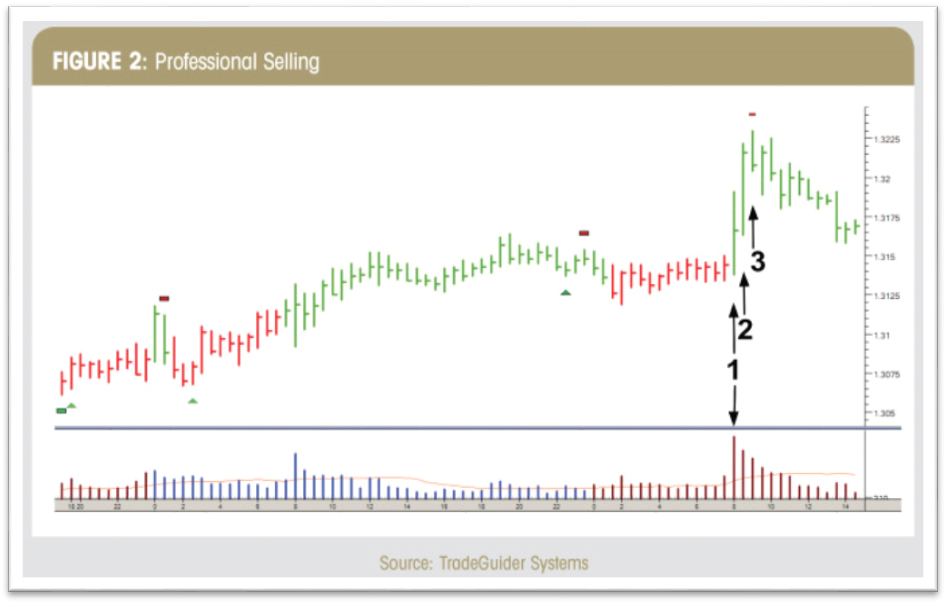
A properly trained trader understands
instantly that when the bar closes in the middle like this, with
massive volume, it signifies a transfer of ownership from the
professionals to what VSA refers to as “weak holders,†traders
that will soon be on the wrong side of the trade. Think of the
analogy used earlier in this article; this is the professional
operators “selling at retail†(distribution) when earlier they
established their positions by “buying at wholesaleâ€
(accumulation). On the bar labeled 2, again we have more selling
from the professionals as they complete the transfer of ownership
to weak hands. The trained trader can see this as the bar labeled 3
is now closing lower, confirming that there was a large block of
selling on the previous bar.
Don’t Be Part of the Herd
Let’s review what just happened on the price
chart here. The professional money has sold their holdings to the
mass public called the “herd†or “weak holders.†The
professionals sold short and the new buyers are locked into a poor
position. How can price continue higher when the professional money
won’t support higher prices and there are no other buyers left to
buy? With no buyers left to support the price, the price falls as
the chart continues on into the mark down process (see Figure 3).
To explain why prices fall in any market, let’s refer to a
previous statement: “For a true downtrend to occur, there must be
a lack of substantial buying (demand) to support the price. The
only traders that can provide this level of buying are the
professional operators, but they have sold at higher price levels
earlier on the chart, during the distribution phase of the
market.â€
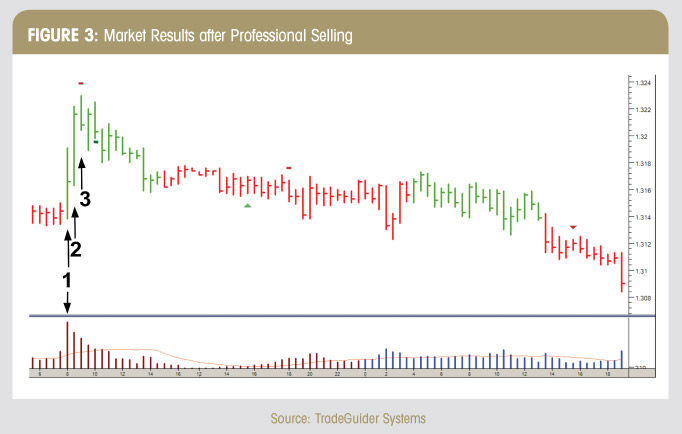
When the price falls far enough, the
professional operator will now enter the market and buy (at
wholesale levels) from the “weak holders,†who are forced to
sell at a substantial loss, and the cycle will repeat itself over
and over again. This is the way all markets work! Because
professional operators specialize in many different markets and
many different time frames, this same sequence of events unfold on
price charts of all durations. We reviewed a 30-minute chart in
this article, but it could just as easily have been a weekly chart.
The market we looked at was forex, but volume spread analysis works
just as well in stocks, futures and commodities. VSA is a market
analysis methodology that alerts the trader to the two most
important questions that they must know the answers to in order to
trade successfully — why and when. Why markets move is based on
the supply and demand from professional operators, and when they
move can be expanded upon once the trader has a more thorough
understanding of volume spread analysis.
HUD (Heads Up Display)
With all of our Intentional
Indicators our attempt is to remove all extraneous information, and
to put the information that we really need for making trade
decisions right in front of us on our charts. This is the “HUDâ€
or “Heads Up Display†approach we take with each of our
indicators. This approach to developing our indicators creates much
cleaner, neater charts and keeps the trader from having to look
away from his or her target in order to make a good trade decision.
It simplifies every trade decision so that they can be made quickly
and accurately.
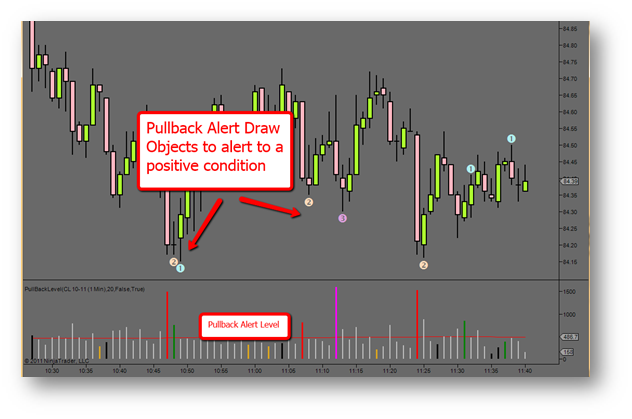
Figure 1 on the main chart area the
PullBackAlert indicator has generated custom draw objects when
the
conditions required to
generate a signal are present. The histogram below is the
PullBackAlertLevel indicator.
For our purposes, we are
simply looking for an indication that price is showing a potential
reversal or pullback from a trend according to an underlying set of
data. It is not important to watch this data in order to determine
if a condition does or does not exist. We simply need to keep our
eyes on our charts and only the necessary information will be used
to alert us to the fact that a condition exists. Therefore the need
for multiple charts, monitors, computers, and indicators is greatly
diminished.
PullBackAlert ships with 2
different indicators that can be applied to a chart.
- PullBackAlert
- PullBackAlertLevel
The first indicator will
generate draw or text objects on a chart to indicate when a
condition is present. This object will print on the close of the
current bar only if the parameters that have been set indicate a
positive condition is present, and will print either above or below
the bar. If it prints above the bar, then a reversal or pullback
sell (short) could be anticipated. If it prints below the bar, then
a reversal or pullback buy (long) could be anticipated.
This indicator is the only
one of the two included that we use in The Intentional Trader trade
rooms. If a trader chooses, he or she could also add the
PullBackAlertLevel indicator to the chart. To get an accurate
picture of what is happening, it is important that the parameter
settings of each indicator are identical to each other.
Parameter Settings

LookBack
The number of bars to look
back to determine min/max values
UseTrueRange
Use the actual range of the
bar or just the high/low of the bar.
Draw Bar Object
Settings
The user has the ability to
use any NinjaTrader drawing object such as dots, arrows, or
triangles as well as using any text to customize how the indicator
appears on the chart.
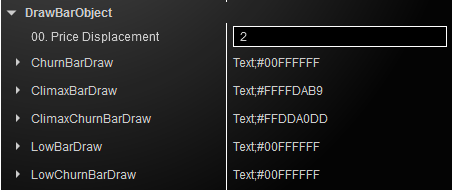
ChurnBar: Churn bars indicate profit taking, new supply entering
the market at tops or new demand entering the market at
bottoms
ClimaxBar: Climax Up bars indicate large volume demand that results
in bidding up prices. Climax Down bars indicate large volume supply
that results in pushing down prices.
ClimaxChurBar: A combination
of the ClimaxBar and ChurnBar
LowBar: Low bars indicate a lack of demand at the tops or a lack
of supply at the bottoms.
Price Displacement
This is the distance from the
top or bottom of the bar that the draw object will print. The lower
the number the closer to the top or bottom of the bar it will
print.
*BarDraw Parameters
Click the “>†sign
next to any of the BarDraw menu items to set the parameters of the
drawing object that prints on the chart to indicate a positive
condition.
This will open up some
selections where you can choose the parameters of the look and
actions of the draw object.

ChangeFont
(see below, Using
Fonts)
Color
Choose from any of the
NinjaTrader default color selections
Font (see below, Using
Fonts)
PaintBar
If you do not want to print a
draw object on your chart, you can choose to have the entire bar or
candlestick paint a color to indicate that a positive condition
exists. Selecting this checkbox will override any other
settings.
RemoveAfterBars
Number of bars after the bar
on which the draw object printed that the draw object will be
removed from the chart.
Type
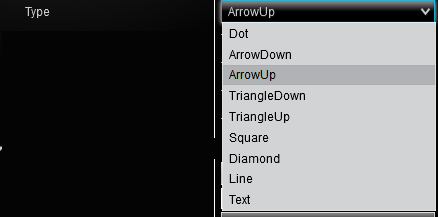
Using Fonts
Select the draw object or
“Textâ€.
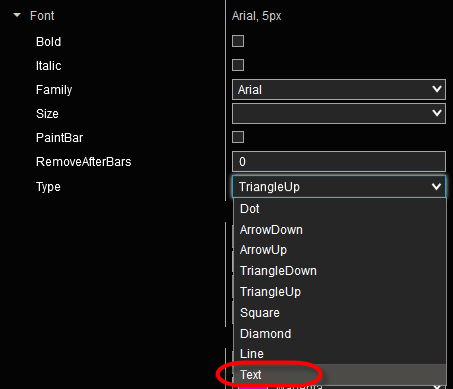
Steps required to change to a
custom printed character:
For illustration, let’s
say the user prefers a star rather than an arrow or other draw
object. How do we display a star on the chart? Follow
the steps below:
- To change to a new custom symbol, select “Text†in the
PullBack Alert indicator settings under DrawBarObject.
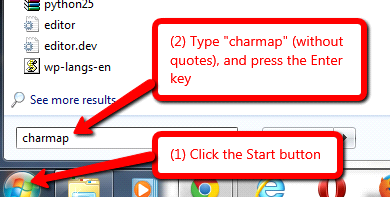
- To view and choose a character set, click on the Windows
Start button. Type charmap
and press Enter.
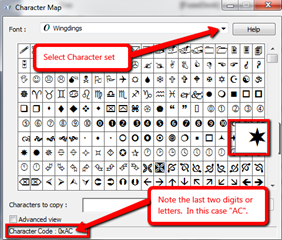
- This last step will bring up all the character sets
available on the local computer. Browse through the options
such as Webdings, Wingdings, or other graphical or text
characters.
- For example, let’s say the user wants a star from the
Wingdings set. Make a note of two pieces of information: (1)
that it is in the Wingdings set; and (2) that the character code
ends in “ACâ€.

- Next, go back to the PullBack Alert indicator settings in
NinjaTrader. Under Font Name, use the pulldown menu to select
the character set from Step 4. For our example, we select
“Wingdings.â€
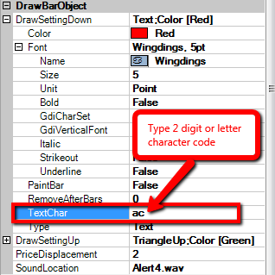
- From Step 4 above, type in the two digit or letter
character code for the particular character that was chosen from
the character set. This is entered in the PullBack Alert
indicator settings under the TextChar settings as shown to the
right.
In this example, we would
type ac (not case sensitive) in the TextChar box in order to get
the Wingdings star.
From here, the user can
select the size and color of the chosen symbol.
















